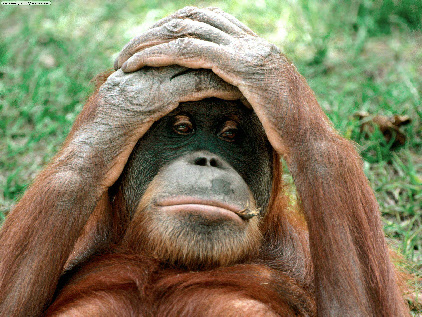science
real

University of St Andrews, Scotland: 2-
Orangutans play charades
Humans are the only form of life on earth that uses written language. But plenty of animals tell each other things using sounds or gestures. Scientists keep being surprised by how well some animals can do this.
A team of scientists at St Andrews University in Scotland has just made a discovery
about how orangutans use gestures to get a message across. It’s very clever -
Along with bonobos, chimpanzees and gorillas, orangutans are the closest living relatives to humans. Together they and we are known as “great apes”. Most of us don’t look much like apes, but we do have a lot in common with them.
Captive orangutans change the signals they are making, or repeat them, depending on whether their audience 'got it' the first time, says Richard Byrne. This is just what people do when they play charades.
The new research is published in 2 August issue of the journal Current Biology.
The orangutans were clearly working out if their audience understood them, says Professor Byrne. This surprised the St Andrews University scientists.
In playing charades, we humans try to get our meaning across without words. We use gestures. And we help our own team with hints about how well they are doing. This is just what orangutans have now been found to do.
The experiment that showed this was set up by Erica Cartmill and Richard Byrne. Their aim was to find out if orangutans intend to communicate with people through gestures. This had already been found in chimpanzees.
The St Andrews experiment worked like this: The scientists presented captive orangutans with two types of food. One was tasty to them; the other wasn't. Both could be reached only with help from the humans.
There was another catch. The scientists sometimes pretended not to understand the orangutans’ requests. So they would sometimes give them only half of the tasty treats. Or they would hand over the yuckier food instead.
When the human didn't get it right the orangutans kept trying to make them understand. They tried new gestures.
But when the humans seemed to partly understand, the apes narrowed down their range of signals. They focused on gestures they had used already. They repeated them, just as humans do in charades.
This showed that the orangutans intended a particular result, Cartmill says. They realised when the humans didn’t get it and when they almost got it, she says.
In the first case they gave up on signals they'd used already. They tried new ones to get the message across. In the second case "they tended to repeat the signals that had already partially worked, keeping at it with vigour.
"The result is that understanding can be achieved more quickly.”
The charades method is one way to build a shared lexicon from learned signals, say the scientists. More study of how apes communicate could help us learn about how the earliest forms of human language began.
More help with words
variety
great apes
report
What's the story about?
- Animals don’t write but they do tell each other things. In what ways do they do this?
- Scientists have made a new discovery about how clever orangutans are in using what to “talk” to humans?
- In which game do people not use words, but try to get their message across using gestures?
- They also try to help their own team with -
- - - - about how well they are doing. - What was the aim of the experiment at St Andrews?.
- Two types of food were used in the experiment. What was the main difference between them?
- Why did the humans pretend not to understand what the orangutans were trying to tell them?
- What did the orangutans do if the humans seemed to partly understand?
- What did the orangutans do if the humans seemed not to understand at all?
- What do you think this story tells scientists about orangutans that they did not know before?
- Imagine you are a member of the St Andrews team of scientists. Try to think of one question you would like answered about orangutans using gestures to "talk" to people.
- Can you think how you might try to answer that question?
Find out more at the Science Centre

Science news
Please mouseover difficult words to see what they mean




